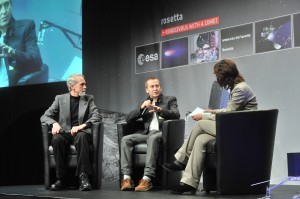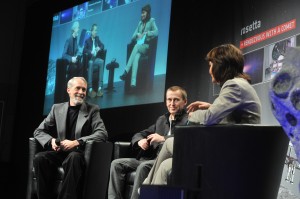
Joel Parker, Deputy Principal Investigator ALICE, and Holger Sierks, Principal Investigator of OSIRIS, talking to moderator Monika Jones during the Rosetta wake-up day at ESA’s European Space Operations Centre, Darmstadt, Germany. (image (c) ESA/J/Mai)
Some of the scientists involved with Rosetta have been sharing their expectations for the mission with the assembled media at the European Space Operations Centre. Holger Sierks, Principal Investigator for OSIRIS, and Joel Parker, Deputy Principal Investigator for ALICE looked ahead to the discoveries they hope for this year.
“We’ve flown by and crashed into comets before, but this time we are looking for a more long-term commitment. We need to see how the comet evolves over its lifetime, ” said Parker. “This is important because what we see from the ground is the large-scale behaviour, the big picture. But what drives the comet is the nucleus. And we simply cannot see the nucleus from here, and that is what Rosetta is going to get us.”
“It’s true we have seen a handful of comets by flyby spacecraft, we have seen lots of comets from Earth. They are there in the sky and common to all of us,” said Sierks. “But it’s so true, comets are cool. Literally. They store the stuff we were built of. It’s the story of us and I think that’s most important to me.”
Since Rosetta launched almost ten years ago, in March 2004, it might be expected that the technology aboard has since been outstripped in terms of performance, but that’s not that case.
“OSIRIS is not a camera for carrying around and taking snapshots,” explained Holger Sierks. “It’s a set of boxes, amounting to 35kg, so you can’t really carry it around! The technology, it’s a 4Mpx camera, not what you would have on your cellphone now, but they are wonderful CCDs that are made for science.”
“A lot of the instruments are still cutting edge technology,” said Joel Parker. “We could perhaps have better resolution or better sensitivity now, but it really is a very advanced laboratory that we are sending to the comet. These are still very advanced instruments that do a lot for very little power.”

Joel Parker, Deputy Principal Investigator ALICE, and Holger Sierks, Principal Investigator of OSIRIS, talking to moderator Monika Jones during the Rosetta wake-up day at ESA’s European Space Operations Centre, Darmstadt, Germany. (image (c) ESA/J.Mai)
Holger Sierks and Joel Parker have a little longer to wait for their instruments to be powered up and checked out. Once OSIRIS is ready in March, Sierks said the team wouldn’t be able to resist taking a picture:
“We are expecting an image of the comet at the end of the instrument checkout. It will not be high resolution, but we will know it’s there and hopefully be able to share the first post-hibernation image with you.”
Joel Parker is looking forward to the comet yielding up its secrets. “We can know about it if we just look at it in the right way. To sniff the gas, check the dust. There are a few things that we expect, but the fun things will be the ones we don’t expect.”









Discussion: no comments